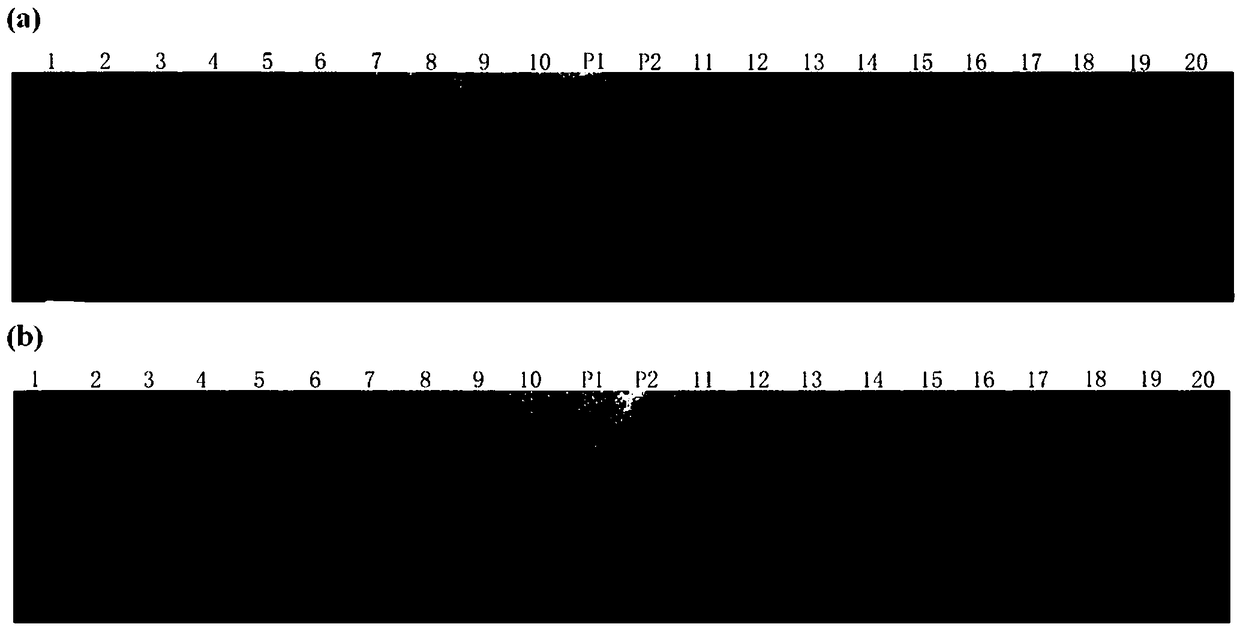SSR (simple sequence repeat) molecular marker L10 closely linked with rice high stalk QTL as well as application thereof
A molecular marker, rice technology, applied in the field of DNA molecular marker technology and molecular biology, can solve the problem of under-saturation of rice SSR marker development
- Summary
- Abstract
- Description
- Claims
- Application Information
AI Technical Summary
Problems solved by technology
Method used
Image
Examples
Embodiment 1
[0029] Example 1 Design of SSR Molecular Markers Tightly Linked to Rice Tall Stalk QTL
[0030] 1.1 Primer design method:
[0031] Molecular marker design is carried out on the chromosome segments where microsatellite markers need to be developed. The sequences of PAC / BAC clones in this region were downloaded from the TIGR website (The Institute of Genome Research) (http: / / www.tigr.org / tdb / rice). TIGR has integrated PAC / BAC clones sequenced by IRGSP (International Rice Genome Sequencing Project, IRGSP) into the genetic map. The sequences of PAC / BAC clones downloaded from the target region first need to use the repetitive sequence search software SSRIT (http: / / www .gramene.org / microsat / ) to search the microsatellite sequence, and then select the appropriate microsatellite sequence (generally require the number of repeats to be more than 8, and avoid the motif being AT), and download a small segment containing the microsatellite sequence Genome sequence (350-500bp), and finall...
Embodiment approach
[0039] Polymorphic screening was carried out by published SSR markers, and the gene controlling rice tall stem was located in the region between the two markers PSM331 and RM1068 on the short and long arm of rice chromosome 1 ( figure 1 , figure 2 ), the specific implementation is as follows:
[0040] According to the polymorphic screening of the published SSR markers (as shown in Table 1), it was found that RM315, PSM331, PSM423, RM104, and RM529, a total of five SSR markers, were polymorphic between the two parents.
[0041] According to the results of molecular marker analysis, the software MAPMAKER (EXP3.0b) was used to analyze the molecular data and calculate the genetic distance between the markers. The plant height gene PH-1(t) was located on the first chromosome, and the genetic distances between the microsatellite markers RM1068, PSM423, RM104 and PH-1(t) on the side of the long arm were 0.5cM, 0.9cM, 8.9cM, and the genetic distances between the microsatellite mark...
Embodiment 2
[0052] Example 2 Application of Rice SSR Molecular Marker L06, SSR Molecular Marker L08, and SSR Molecular Marker L10
[0053] 2.1 Rice genomic DNA extraction
[0054] The total DNA of rice genome was extracted by the improved TPS simple method, and the specific steps were as follows:
[0055] 1. At the peak tillering stage, take 1 to 2 young leaves from the upper part of each plant, and store them in a -80°C refrigerator for later use;
[0056] 2. When extracting DNA, take 2-4cm long rice leaves and put them into a 1.5ml centrifuge tube, put them in liquid nitrogen, grind them, add 900ml of TPS extract solution, and bathe in 75°C water bath for 30-60min;
[0057] 3. Centrifuge at 12000rpm for 10min, absorb about 500ml of the supernatant and transfer to a new 1.5ml centrifuge tube;
[0058] 4. Add pre-cooled isopropanol or absolute ethanol to top up. Overnight at 4°C, centrifuge at 12000rpm for 10min;
[0059] 5. Discard the supernatant, dry the precipitate, add 150 μl ste...
PUM
 Login to View More
Login to View More Abstract
Description
Claims
Application Information
 Login to View More
Login to View More - R&D
- Intellectual Property
- Life Sciences
- Materials
- Tech Scout
- Unparalleled Data Quality
- Higher Quality Content
- 60% Fewer Hallucinations
Browse by: Latest US Patents, China's latest patents, Technical Efficacy Thesaurus, Application Domain, Technology Topic, Popular Technical Reports.
© 2025 PatSnap. All rights reserved.Legal|Privacy policy|Modern Slavery Act Transparency Statement|Sitemap|About US| Contact US: help@patsnap.com



